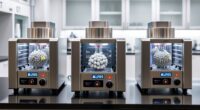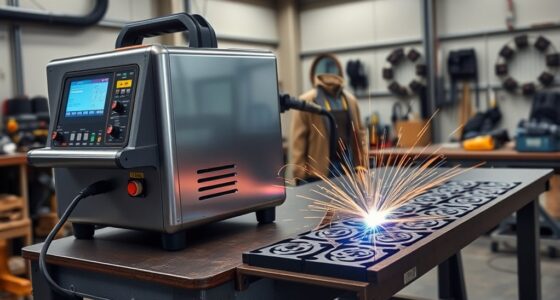If you’re seeking the 14 best ultrasonic homogenizers of 2025 for precision and efficiency, I’ve found a range of devices that combine power, versatility, and user-friendly features. These models include handheld, portable units with adjustable settings, durable titanium probes, and advanced safety protections suitable for small labs or industrial use. To guarantee you pick the right one, consider factors like power, sample volume, and control options—if you keep exploring, you’ll discover the perfect match.
Key Takeaways
- Features advanced adjustable power, frequency, and multiple operation modes for tailored sample processing.
- Includes models with durable titanium probes suitable for volumes from 0.1mL to 3 liters.
- Offers safety protections like over-temperature and overload alarms for reliable operation.
- Incorporates digital controls, real-time monitoring, and user-friendly interfaces for precise results.
- Caters to diverse users, from researchers to hobbyists, with portable designs and heavy-duty industrial options.
Bonvoisin Ultrasonic Homogenizer Emulsifier Sonicator Processor

The Bonvoisin Ultrasonic Homogenizer Emulsifier Sonicator Processor is an excellent choice for those needing versatile, lab-grade performance in a compact, handheld design. I’ve found it perfect for particle dispersion, emulsification, and accelerating chemical reactions in small samples. Its adjustable power and frequency (30KHz) let me tailor settings for different tasks, whether making salad dressings or dissolving polymers. The titanium alloy probe handles various container sizes, and the device’s sturdy build ensures reliable operation. Despite some power discrepancies, users report it efficiently emulsifies and homogenizes liquids. Overall, it’s a portable, effective tool suitable for both professional and home labs.
Best For: researchers, laboratory technicians, and home hobbyists seeking versatile, portable ultrasonic processing for emulsification, homogenization, and sample preparation.
Pros:
- Compact, handheld design for ease of use and portability
- Adjustable power and frequency (30KHz) for versatile applications
- Suitable for processing samples from 50-300mL with various probe sizes
Cons:
- Power supply may be underwhelming compared to advertised wattage (sold as 500W but typically 120W)
- Stand and accessories may not fit perfectly, requiring modifications or careful handling
- Overheating can occur if used continuously without proper rest periods
Bonvoisin Ultrasonic Homogenizer Emulsifier Cell Disruptor

If you’re seeking a versatile and affordable ultrasonic homogenizer for small-scale lab or hobbyist projects, the Bonvoisin Ultrasonic Homogenizer Emulsifier Cell Disruptor stands out. Designed for particle dispersion, emulsification, and accelerating chemical reactions, it handles 0.1-30mL samples easily. Operating at 30KHz with up to 150W power, it features a durable titanium alloy probe and adjustable settings for amplitude and power. Its automatic frequency tracking and overload protection guarantee stable, reliable performance. Packaged with a sturdy case and stand, it’s comfortable to hold and transport. Overall, it offers a cost-effective solution for laboratory and home use, delivering professional results in a compact, user-friendly design.
Best For: hobbyists, small laboratory researchers, and DIY professionals seeking an affordable, compact ultrasonic homogenizer for small-scale sample processing and emulsification.
Pros:
- Cost-effective and suitable for both laboratory and home use
- Durable titanium alloy probe with adjustable amplitude and power settings
- Automatic frequency tracking and overload protection for stable operation
Cons:
- Power supply ratings may differ from advertised specifications, potentially affecting performance
- Some accessories like the stand may not fit perfectly, requiring adjustments
- Adjustable stand feature is lacking, which could enhance usability
Handheld Ultrasonic Homogenizer Lab Emulsifier Mixer with Titanium Probe

For researchers seeking a versatile and portable ultrasonic homogenizer, the Handheld Ultrasonic Homogenizer Lab Emulsifier Mixer with Titanium Probe stands out. Its lightweight, compact design with one-key startup makes it easy to operate, whether handheld or fixed on a bracket. The titanium alloy probe ensures durability, high precision, corrosion resistance, and high-temperature tolerance, ideal for demanding lab tasks. With a maximum power of 300W and a frequency of 30kHz, it efficiently handles volumes from 0.1 to 30ml. Equipped with double insulation safety features, it guarantees safe, reliable operation across applications like cell crushing, emulsification, and chemical synthesis.
Best For: researchers and laboratory professionals needing a portable, durable ultrasonic homogenizer for precise mixing, emulsification, and cell disruption tasks.
Pros:
- Lightweight and compact design for easy handling and versatile application.
- Titanium alloy probe offers high durability, corrosion resistance, and high-temperature tolerance.
- Safe operation with double insulation safety device and straightforward one-key startup.
Cons:
- Processing capacity limited to small volumes (0.1~30ml), not suitable for large-scale applications.
- Requires a power source with input voltage between 100-240V AC, limiting mobility in areas with incompatible outlets.
- May need additional accessories or brackets for fixed installation in certain laboratory setups.
U.S. Solid Ultrasonic Homogenizer Ultrasonic Processor

Designed for laboratories and industrial settings that demand reliable ultrasonic processing, the U.S. Solid Ultrasonic Homogenizer Ultrasonic Processor offers versatility and safety. With 600W power and a probe diameter of 16 mm, it handles sample volumes from 25 to 500 ml efficiently. Its dual modes—continuous and pulse—allow precise control over processing. Safety is prioritized with a real-time temperature sensor that halts operation if needed. The large LCD display, adjustable timers, and sound abating chamber make operation intuitive and quiet. This device excels in mixing, emulsifying, cell disruption, and particle reduction, making it an ideal choice for demanding ultrasonic applications.
Best For: researchers and industrial professionals seeking reliable, versatile ultrasonic processing for sample volumes between 25 and 500 ml with safety and noise control features.
Pros:
- Precise control with dual operation modes (continuous and pulse) and adjustable timers.
- Built-in temperature sensor enhances safety and protects equipment during operation.
- Quiet operation facilitated by an integrated sound abating chamber, reducing cavitation noise.
Cons:
- Limited sample volume range (25-500 ml) may not suit larger-scale applications.
- Requires manual shutdown in continuous mode, which may be less convenient for extended processing.
- The device’s 600W power may be excessive for very small or delicate samples, risking over-processing.
Handheld Ultrasonic Homogenizer for Lab Emulsification (0.3-500ml, Ø8mm Probe)
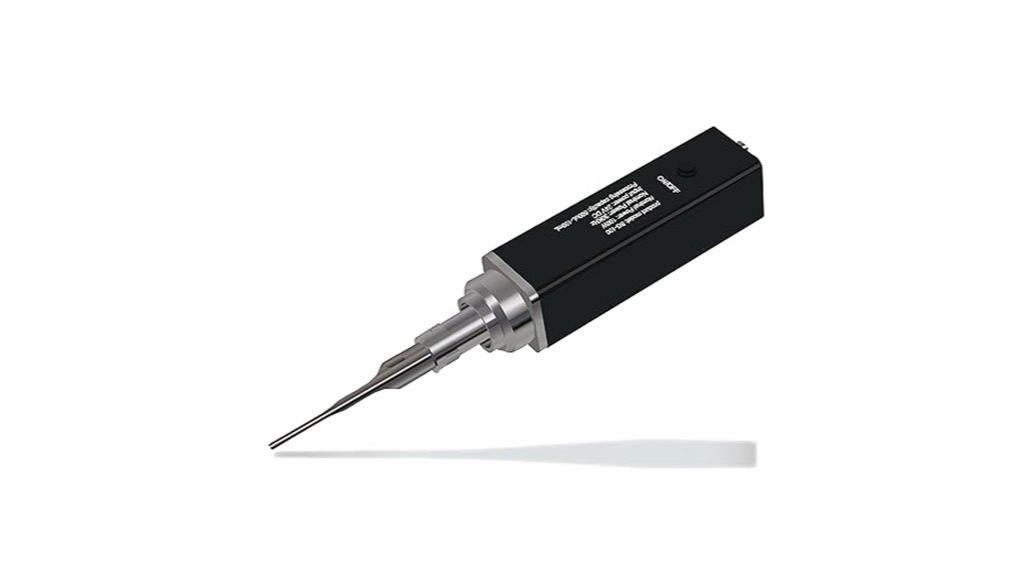
The handheld ultrasonic homogenizer with an Ø8mm titanium alloy probe stands out as an ideal choice for researchers seeking precise and versatile sample processing. Its lightweight, compact design allows easy handling or mounting on a stand, making it suitable for various lab setups. The durable titanium alloy probe resists high temperatures, acids, and alkalis, ensuring longevity during demanding tasks. With eight adjustable power levels up to 120W and a smart frequency sweep circuit, it offers reliable control and consistent results. Perfect for emulsification, cell disruption, nanoparticle dispersion, and sample prep, this device combines portability with performance for efficient laboratory work.
Best For: researchers and laboratory professionals needing precise, versatile, and portable sample processing for emulsification, cell disruption, and nanoparticle dispersion.
Pros:
- Lightweight, compact design for easy handling and mounting options
- Durable titanium alloy probe resistant to high temperatures and corrosive substances
- Adjustable power levels up to 120W with smart frequency sweep for consistent results
Cons:
- Limited probe sizes may restrict use in very large or very small sample volumes
- Requires familiarity with ultrasonic homogenization for optimal operation
- The device’s portability might compromise stability during prolonged use on uneven surfaces
CGOLDENWALL Handheld Ultrasonic Homogenizer Sonicator Processor
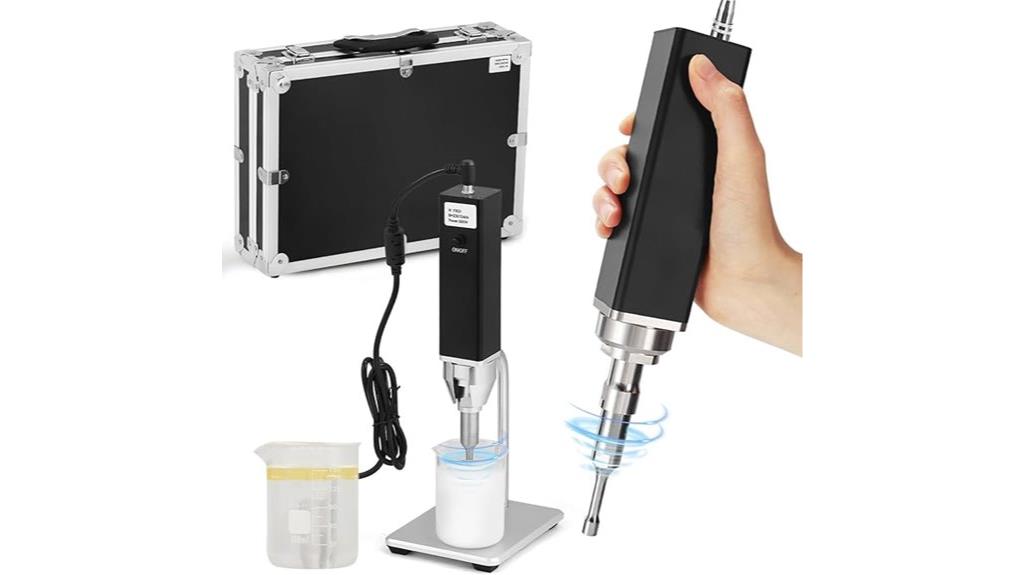
If you’re seeking a portable yet powerful ultrasonic homogenizer for small-scale experiments, the CGOLDENWALL Handheld Ultrasonic Homogenizer Sonicator Processor stands out with its compact design and efficient performance. It features an 8mm titanium alloy probe, perfect for dispersing, blending, emulsifying, and breaking cell walls in samples of 50-300mL. With a 30KHz frequency and up to 500W power, it delivers strong ultrasonic energy while remaining easy to operate via one-click start. Its advanced circuitry guarantees stable operation, though overheating during prolonged use can be a concern. Overall, it’s ideal for material dispersion, plant extraction, and small lab tasks, offering portability without sacrificing power.
Best For: researchers and small laboratories seeking a portable, high-performance ultrasonic homogenizer for micro-volume sample processing and cell disruption tasks.
Pros:
- Compact and lightweight design for easy handheld use and portability
- Powerful ultrasonic energy with up to 500W output and stable operation features
- Suitable for dispersing, emulsifying, and breaking cell walls in small sample volumes
Cons:
- Overheating may occur during extended use, potentially shutting down the device
- Stand adjustment can be difficult, affecting optimal container placement and probe immersion depth
- Limited processing capacity (50-300mL), not ideal for large-scale applications
100W Portable Ultrasonic Homogenizer with Stand and 6mm Probe

For those needing a versatile and portable ultrasonic homogenizer, the W Portable Ultrasonic Homogenizer with Stand and 6mm Probe stands out as an excellent choice. It’s a lightweight, durable device with a sleek aluminum shell and a high-temperature resistant titanium probe. With 100W power and a 30kHz frequency, it provides adjustable output up to 150W. Its compact size (265x42x42mm) and 1kg weight make it easy to handle or mount on a stand. Suitable for processing 50-300mL samples in EP tubes, it features automatic amplitude control, temperature protection, and multiple power options for flexible, efficient operation.
Best For: researchers and laboratory professionals seeking a portable, versatile ultrasonic homogenizer for sample processing, emulsification, and cell disruption.
Pros:
- Compact and lightweight design for easy handling and mounting on a stand.
- Adjustable power up to 150W with automatic features like amplitude control and temperature protection.
- Durable construction with a titanium alloy probe resistant to high temperatures and wear.
Cons:
- Continuous operation can lead to overheating, requiring cooling periods before reuse.
- Limited processing capacity of 50-300mL, which may not suit larger sample volumes.
- Requires careful handling to avoid probe damage and ensure safety during ultrasonic operation.
Ultrasonic Sonicator with Probe, 500W, 0.5-500ml, 18-25kHz, Electric Lift, Built-in Light, Temperature Probe

This ultrasonic sonicator with probe stands out for its precise temperature control and user-friendly features, making it ideal for laboratories that require accurate processing of small to medium samples. With 500W power and a frequency range of 18-25kHz, it handles 0.5-500ml samples efficiently. The device’s electric lift and built-in light improve usability and visibility during operation. It also includes real-time temperature monitoring and automatic frequency tuning to guarantee consistent results. The 7-inch touch screen offers intuitive control over energy and temperature settings, providing the flexibility needed for diverse ultrasonic processing tasks. Overall, it combines power, precision, and convenience in a compact design.
Best For: researchers and laboratory technicians who need precise ultrasonic processing of small to medium-sized samples with user-friendly controls and accurate temperature regulation.
Pros:
- Precise temperature control and real-time monitoring for consistent results
- User-friendly 7-inch touch screen with intuitive digital controls
- Versatile handling of samples from 0.5 to 500ml with electric lift and built-in lighting
Cons:
- Limited to samples within 0.5-500ml, not suitable for larger volumes
- Requires electrical power and may need specific maintenance for the probe and lift system
- Potentially higher cost due to advanced features and precision controls
U.S. Solid Ultrasonic Homogenizer 750W

The U.S. Solid Ultrasonic Homogenizer 750W offers powerful performance with its 750W ultrasonic vibration, ensuring efficient mixing, emulsification, dispersion, and cell disruption. Its solid probe, measuring 250mm long and 25mm in diameter, is built for durability and rigorous use. Capable of handling sample volumes up to 3 liters, it suits both laboratory and industrial needs. Its versatile design makes it ideal for various applications, including emulsification and cell disruption. Plus, its user-friendly setup guarantees smooth operation and easy handling, making it a reliable choice for demanding processes that require precision and efficiency.
Best For: researchers and industrial professionals needing efficient, reliable ultrasonic homogenization for large-volume samples up to 3 liters.
Pros:
- High 750W ultrasonic power for demanding applications
- Durable solid probe designed for rigorous use
- Versatile for emulsification, dispersion, and cell disruption
Cons:
- May be heavy or cumbersome for prolonged manual handling
- Requires proper maintenance to ensure longevity
- Not suitable for very small sample volumes below 1 liter
U.S. Solid Touch Screen Ultrasonic Homogenizer (300W, 0.1-200ml)
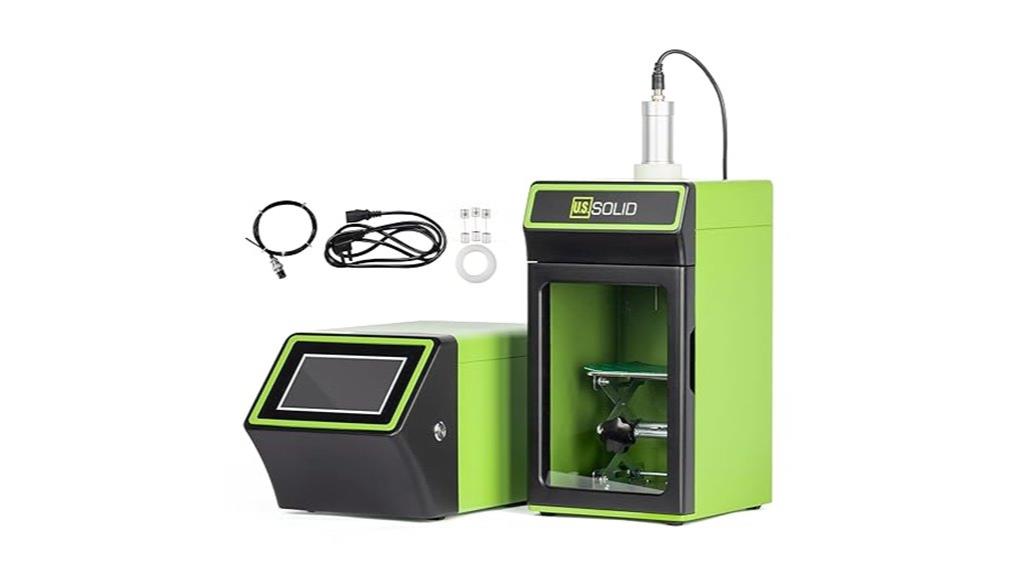
Looking for an ultrasonic homogenizer that combines ease of use with precise control? The U.S. Solid Touch Screen Ultrasonic Homogenizer (300W, 0.1-200ml) offers a sleek 7-inch touchscreen interface that simplifies adjusting settings like power, frequency, and mode. You can save up to 10 custom profiles for quick setup, making repetitive tasks effortless. With three operational modes—Continuous, Timed, and Pulse—you can tailor the process to your needs. Its titanium probes are durable and corrosion-resistant, ensuring longevity. Plus, built-in over-temperature protection keeps your samples safe during intensive processing. It’s a reliable, user-friendly choice for precise laboratory applications.
Best For: researchers and laboratory technicians seeking a user-friendly ultrasonic homogenizer with precise control and durable probes for small to medium sample volumes.
Pros:
- Intuitive 7-inch touchscreen interface with easy adjustment of settings
- Stores up to 10 custom user profiles for quick setup and repeatability
- Multiple operational modes (Continuous, Timed, Pulse) for versatile use
Cons:
- Limited to processing sample volumes up to 200ml, not suitable for larger batches
- May require familiarity with ultrasonic processing parameters for optimal results
- Higher initial cost compared to basic homogenizers
U.S. Solid Ultrasonic Homogenizer Ultrasonic Processor

For researchers and laboratories seeking a reliable ultrasonic processor, the U.S. Solid Ultrasonic Homogenizer Ultrasonic Processor is an excellent choice. It offers 600W of power and handles sample volumes from 25 ml to 500 ml with a 16 mm probe. The device features two modes: continuous for nonstop operation and pulse for controlled processing, with real-time temperature monitoring to prevent overheating. Its large LCD display and precise timers allow for accurate control over processing time. Plus, its sound abating chamber reduces noise, making work more comfortable. Versatile and user-friendly, it’s suitable for mixing, dispersing, cell disruption, and more across various applications.
Best For: researchers and laboratories requiring a versatile, high-power ultrasonic processor for sample volumes up to 500 ml across various applications.
Pros:
- Offers adjustable continuous and pulse operation modes for flexible processing control
- Equipped with real-time temperature monitoring to enhance safety and protect samples
- Features a sound abating chamber that significantly reduces cavitation noise for a quieter workspace
Cons:
- Manual shutdown needed for continuous mode, which may be less convenient during extended operations
- Limited sample volume capacity up to 500 ml, potentially restricting larger-scale applications
- The device’s complexity and advanced features may require some training for optimal use
CGOLDENWALL Handheld Ultrasonic Homogenizer Sonicator Processor
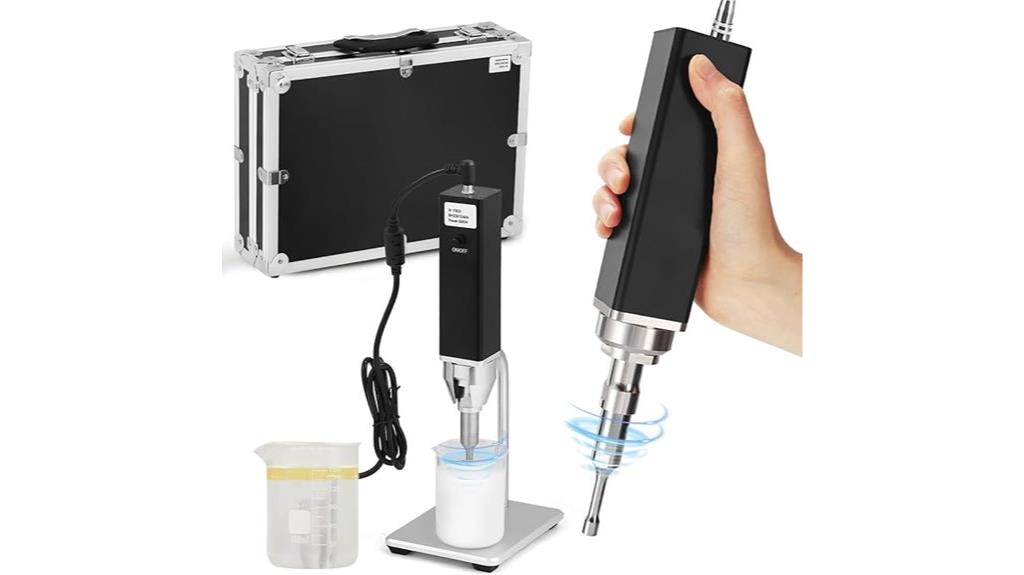
If you need a versatile ultrasonic homogenizer for small-scale laboratory tasks, the CGOLDENWALL Handheld Ultrasonic Homogenizer Sonicator Processor stands out thanks to its compact design and powerful 300W output. It features an 8mm titanium alloy probe, perfect for dispersing, blending, emulsifying, and breaking cell walls in samples up to 300mL. Its advanced circuitry offers automatic frequency tracking, amplitude control, and overheating protection, making it easy to operate with one click. While suitable for nano-particle dispersion and small-scale processing, some users note overheating during extended use. Overall, it’s a reliable tool for micro-sample applications, combining portability with effective ultrasound energy delivery.
Best For: micro-scale laboratory researchers and professionals requiring portable, effective ultrasonic homogenization for small sample processing and cell disruption.
Pros:
- Compact and lightweight design for easy handheld operation and portability
- Powerful 300W output with advanced circuitry for stable ultrasound energy delivery
- Suitable for dispersing, blending, emulsifying, and breaking cell walls in samples up to 300mL
Cons:
- Overheating during extended use can cause device shutdown
- Stand adjustment can be difficult, affecting container positioning and probe immersion depth
- Limited to small-scale processing, not ideal for larger sample volumes or high-throughput applications
UXI Handheld Ultrasonic Homogenizer Lab Disruptor Sonicator with Carry Case

The UXI Handheld Ultrasonic Homogenizer Lab Disruptor Sonicator stands out for researchers and laboratory professionals who need a portable, easy-to-use device for small-scale sample processing. Its compact and lightweight design makes it ideal for manual handling or mounting with an optional bracket. Compatible with a wide voltage range (100-230V), it offers versatility across regions. Perfect for processing samples from 0.1 to 300 ml, it features high-durability titanium alloy probes for durability and heat resistance. With automatic frequency tracking and amplitude compensation, it guarantees stable operation and efficient cell disruption, making it an excellent choice for diverse laboratory applications.
Best For: researchers and laboratory professionals requiring a portable, small-scale ultrasonic homogenizer for efficient sample processing and cell disruption.
Pros:
- Compact and lightweight design for easy handling and portability
- Wide voltage compatibility (100-230V) suitable for global use
- Durable titanium alloy probes ensure long-lasting performance and heat resistance
Cons:
- No included bracket for fixed mounting, requiring optional accessories for hands-free operation
- Limited to small sample volumes (0.1 to 300 ml), not suitable for large-scale processing
- Power specifications may raise concerns for some users despite reliable performance
U.S. Solid 2-in-1 Ultrasonic Homogenizer Sonicator Cell Disruptor Mixer
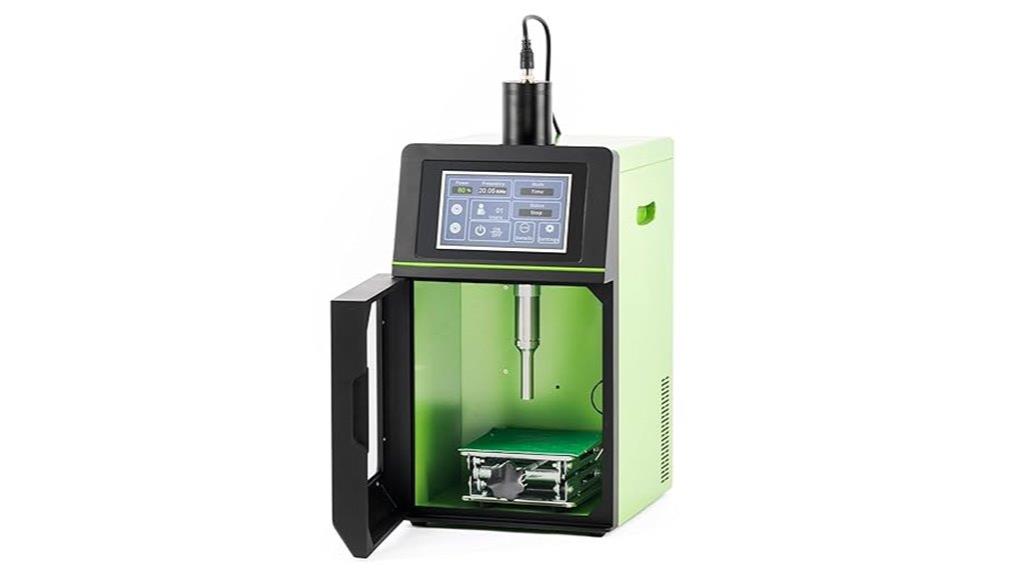
Designed for researchers and professionals needing reliable sample processing, the U.S. Solid 2-in-1 Ultrasonic Homogenizer Sonicator Cell Disruptor Mixer combines efficiency and space-saving design. Its compact unit features a built-in soundproof box and interior LED light for clear visibility during operation. With up to 10 customizable settings, you can quickly access models, run times, and shutdown temperatures. The device offers three operational modes: Continuous, Timed, and Pulse, allowing flexible processing. Safety is prioritized with over-temperature protection that automatically shuts down the system if limits are exceeded. Its self-adjusting energy guarantees ideal performance across diverse applications, from cell disruption to chemical synthesis.
Best For: researchers and professionals seeking a reliable, space-saving ultrasonic homogenizer for diverse sample processing applications.
Pros:
- Combines ultrasonic homogenizer with soundproof box and LED light for enhanced usability and visibility.
- Offers up to 10 customizable settings for quick access to preferred configurations.
- Features over-temperature protection and automatic energy adjustment for safety and optimal performance.
Cons:
- May have a learning curve for users unfamiliar with ultrasonic processing modes.
- Limited information on maximum sample volume capacity.
- Potentially higher cost compared to basic homogenizers without advanced features.
Factors to Consider When Choosing Ultrasonic Homogenizers
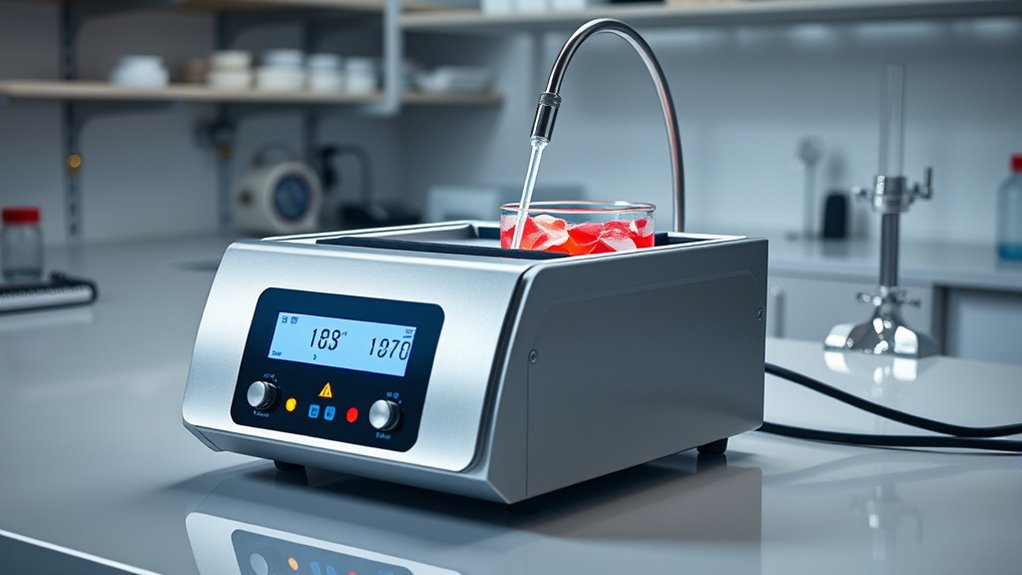
When selecting an ultrasonic homogenizer, I focus on key factors like power and intensity to match my samples’ needs. Compatibility with sample volume and probe material quality also matter to guarantee durability and efficiency. Additionally, adjustable power settings and flexible operational modes help me tailor the device for different applications.
Power and Intensity
Power and intensity are critical factors in selecting an ultrasonic homogenizer because they directly impact the device’s ability to produce effective cavitation forces essential for disrupting and emulsifying samples. Higher wattage, such as 300W or more, allows for larger volume processing and faster results, while lower power suits micro-sample work. The amplitude, which is often adjustable, controls the vigor of cavitation; higher amplitudes generate more vigorous disruption. Frequency, generally fixed at 20-30kHz, influences cavitation bubble size and energy, affecting efficiency across different materials. Ultrasonic intensity combines power and amplitude, so balancing these elements with sample viscosity and volume is key. Proper adjustment prevents overheating and sample damage, ensuring ideal performance tailored to your specific application.
Sample Volume Compatibility
Choosing the right ultrasonic homogenizer depends heavily on matching its maximum sample volume to your specific needs. I always guarantee the device’s capacity aligns with my processing requirements to avoid overloading or inefficiency. Probe size and design are critical; larger probes handle higher volumes, while smaller probes suit micro-samples. I verify the recommended sample volume range, which typically spans from microliters to liters, to match my experiments or production scale. Processing outside this range can cause poor emulsification, incomplete homogenization, or damage the equipment. If my sample volume varies, I prefer models with adjustable power and frequency settings for better control. Proper compatibility ensures ideal performance, longevity, and consistent results in my homogenization tasks.
Probe Material Quality
Selecting the right probe material is essential for guaranteeing reliable and efficient ultrasonic homogenization. High-quality materials like titanium alloys are ideal because they are strong, resistant to corrosion, and can withstand high temperatures. This durability extends the probe’s lifespan and maintains consistent performance during demanding laboratory processes. The quality of the probe material directly impacts how effectively ultrasonic energy is transferred; better materials enable more uniform and efficient processing. Using inferior materials can lead to probe degradation or breakage, risking sample contamination and frequent replacements. Choosing probes made from medical-grade or aerospace-grade materials ensures longevity and reliable operation. Ultimately, investing in high-quality probe materials minimizes downtime, enhances processing precision, and safeguards your samples over the long term.
Adjustable Power Settings
Having adjustable power settings on ultrasonic homogenizers is essential because they let you tailor the ultrasonic energy to suit different sample types and volumes. This control helps optimize processing, ensuring effective homogenization without risking sample overheating or damage. Precise power adjustment allows me to fine-tune the intensity during experiments, leading to better reproducibility and consistent results. Whether I need gentle homogenization or aggressive cell disruption, variable power levels provide the versatility necessary for diverse procedures. Many devices feature incremental controls or digital interfaces, making it easy to make accurate adjustments on the fly. By selecting a homogenizer with adjustable power, I can customize the treatment to match my specific sample requirements, improving both efficiency and outcome quality.
Operational Modes Flexibility
Operational modes flexibility is essential because it allows me to adapt the ultrasonic homogenizer’s performance to different sample types and processing requirements. With multiple modes like continuous, pulse, and timed, I can tailor my approach for specific tasks. Continuous mode delivers nonstop energy, perfect for large volumes or intensive processing. Pulse mode alternates sonication and rest intervals, reducing heat buildup and preventing sample degradation during prolonged use. Timed operation helps me control the exact duration of treatment, ensuring consistency and repeatability. This versatility makes the homogenizer suitable for a broad range of applications, from gentle cell disruption to demanding emulsification. Having flexible operational modes ensures I can optimize performance, protect samples, and improve overall efficiency in my laboratory workflows.
Safety and Overheat Protection
Ensuring safety and preventing equipment damage are crucial when choosing an ultrasonic homogenizer, especially during prolonged or high-intensity processing. Over-temperature protection features are essential because they automatically shut down the device if internal temperatures become unsafe, preventing damage and ensuring user safety. Many models include real-time temperature sensors that continuously monitor sample temperature, triggering shutdowns or pauses when preset thresholds are exceeded. Proper overheat protection safeguards electronic components and maintains sample integrity by preventing overheating-induced degradation. Devices with automatic temperature regulation can extend the lifespan by reducing thermal stress on probes and circuitry during extended use. These systems are especially essential when processing viscous, high-volume, or heat-sensitive samples, where excessive heat could compromise results or pose safety risks.
Ease of Use Design
When choosing an ultrasonic homogenizer, ease of use is a key factor that can make your work more efficient and less frustrating. An ergonomic, lightweight design with a one-key start simplifies operation and reduces user fatigue, allowing for longer sessions with less strain. Clear control panels featuring digital displays and intuitive interfaces make adjusting power, frequency, and processing time straightforward, saving you time and minimizing errors. Handheld units with adjustable stands or mounts offer versatile positioning, enhancing convenience during experiments. Safety features like automatic shutoff and overload protection help prevent accidental damage and ensure safe operation. Additionally, user-friendly accessories, such as easy-to-assemble probes and quick-change adapters, streamline sample processing, making the entire experience more seamless and efficient.
Portability and Size
Choosing an ultrasonic homogenizer with the right size and portability can make a significant difference in how easily you can use it across different settings. Portable models typically weigh between 1 kg and 7.5 pounds, making them easy to carry and operate almost anywhere. Compact designs, often less than 16 inches long, allow for handheld use and simple storage. Size and weight directly impact handling comfort, especially during prolonged use or when mounted on stands. Smaller units are ideal for processing up to 300 mL samples, while larger portable models can handle higher volumes with additional attachments. Adding a stand or carrying case enhances portability, protecting the device and facilitating transport. Choosing the right size ensures efficiency without sacrificing convenience.
Frequently Asked Questions
What Are the Maintenance Requirements for Different Ultrasonic Homogenizer Models?
Maintenance requirements vary between models but generally include regular cleaning to prevent buildup, inspecting and replacing worn or damaged probes, and guaranteeing proper cooling. I recommend checking the manufacturer’s guidelines for specific schedules and procedures. I always make sure to keep the device dry, avoid using harsh chemicals, and perform routine calibrations to maintain ideal performance. Proper maintenance extends the lifespan and ensures consistent, precise results.
How Do Ultrasonic Frequency and Power Influence Sample Processing Quality?
Ultrasonic frequency and power directly impact sample processing quality by determining the energy delivered and the size reduction achieved. Higher frequencies offer finer emulsification, while increased power ensures thorough cell disruption and uniform particle size. I always match the frequency and power settings to my specific sample needs, balancing efficiency and precision. Proper adjustment ensures ideal results without overheating or damaging delicate samples, making my processes more reliable and effective.
Are There Specific Safety Precautions for Handheld Versus Benchtop Homogenizers?
Yes, there are specific safety precautions for handheld versus benchtop homogenizers. For handheld devices, I always wear eye protection and hold the unit securely to prevent accidental splashes or drops. With benchtop models, I guarantee the unit is properly grounded, keep the area clear of clutter, and avoid direct contact with the probe while in operation. Both require careful handling to prevent injury and ensure ideal sample processing.
Can Ultrasonic Homogenizers Handle Viscous or High-Solid-Content Samples?
Did you know ultrasonic homogenizers can process samples with up to 80% solids? I’ve found they handle viscous or high-solid-content samples quite well, especially with proper probe selection and adjusting amplitude settings. I always recommend pre-diluting overly thick samples or using specialized probes to guarantee efficient energy transfer. With the right setup, ultrasonic homogenizers deliver consistent, high-quality results even for challenging, viscous materials.
What Are the Compatibility Options for Probes and Accessories Across Brands?
Probes and accessories are generally compatible across brands, but it’s essential to check the specific manufacturer’s specifications. I always verify the size, connector type, and power requirements before purchasing or swapping parts. Some brands offer universal or interchangeable probes, which make upgrades easier. I recommend sticking to reputable brands known for quality and compatibility to avoid issues and guarantee maximum performance with your ultrasonic homogenizer.
Conclusion
Choosing the right ultrasonic homogenizer isn’t just about power; it’s about precision meeting efficiency. Imagine a lab where every sample is perfectly emulsified, yet the device fits comfortably in your hand—like a trusted partner. Whether you need a compact handheld or a powerful processor, the options blend innovation with practicality. In this world of advanced tech, your ideal homogenizer is the one that seamlessly balances performance and ease, revealing new possibilities in your work.

